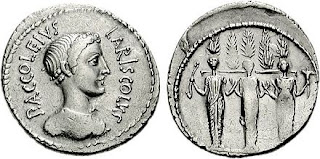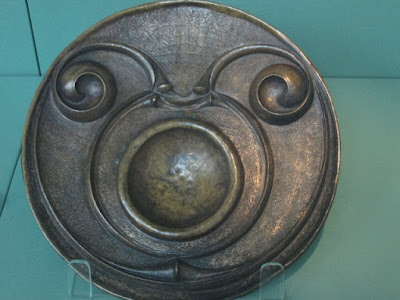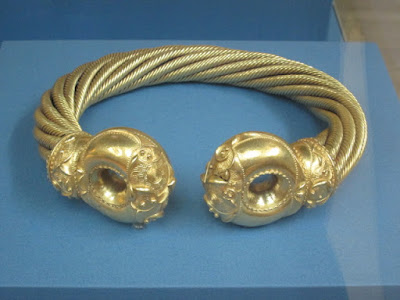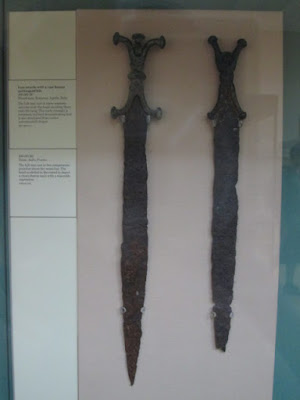Let's return to this blog after handing in my PhD thesis with a fourth post about my visits to the British Museum (Anglosaxons, Vikings, Egypt and Greece)! Today's historical pic-overload will be about one of my favourite Ancient culture, the Celts, including pics from my visits in 2014 and 2019.
This will be quite a lengthy post, as I took a *lot* of pics xD I will include the descriptions from the museum both as text mostly as quotes in italics. As usual, click on the pics and/or open in a new tab for larger size, especially to read the text!
Celtic culture: Around 450 BC people in Iron Age Europe began decorating objects in a new style known today as 'Celtic' or 'La Tène' art. These designs generally featured abstract flowing patterns and entwined plant motifs, although styles varied from one region to another. Objects decorated in this fashion were often made using complex methods and requrired great skill. Across Europe, Celtic art continued to develop and influence decorative style well into the Medieval period.
The culture of the Celtic-speaking peoples of Britain and Ireland was distinctive in many ways. They developed a new art style that fused traditional swirling and geometric designs with Roman motifs and Germanic-style interlaced animals, while characteristic dress accessories and techniques like enamelling were popular. They also exploited links with the distant Mediterranean, trading resources like leather and tin from south-west Britain for wine and oil.
Open ring (pennanular) brooches:
Open ring brooches were the distinctive dress fasteners of
Celtic-speaking Britain and Ireland. Imagery shows men and women wearing
them at the shoulder or breast with the pin pointing horizontally or
diagonally upwards, perhaps depending upon gender or regional taste.
The positioning and use of pennanular brooches was indeed differentiated both by gender and social status :S Men usually wore them at the shoulder, while women wore them at the breast (well, tough, because I prefer to wear them at the shoulder xD), with the pin pointing up. This seems to have been regulated by law, as the Brehon Law (Medieval Ireland's law codes) addressed the potential injury from some of these very long and very pointy brooch pins at crowds, stating that the wearer would not be at fault if the pin didn't protrude beyond the shoulder, and if it was worn 'in these ways by the sexes': "Men are exempted from liability to fine from injury from the pin of their brooch if they have the brooch on their shoulder so as not to project beyond it. Women also are exempt if they have their brooch similarly at their bosom." (source).
So, if a woman had her brooch at her shoulder without the pin protruding and someone injured themself from it, she would be fined, while a man would not. As usual, gendering stuff sucks and is illogical af. Why does it matter if a brooch is worn at the shoulder or chest by any gender? What should be more important is to ensure that the pins, which could get incredibly long and incredibly pointy, as illustrated above, would have toppers or something to protect other people from potential injuries in crowds! The priorities, people, the priorities!
 |
| Oh no, I was wearing it wrong all along xDD |
Silver disc-headed pin, AD 400s: This massive Irish dress pin owes much to Roman influence. The silver used to make it was rare in Ireland and probably came from melted-down Roman plate or coins. Its decoration of chip-carved spirals, scrolls and stylized leaf and fruit motifs derives from late Roman military belt fittings, while the red enamel inlay and crescent-like pelta motifs on the pin head were inherited from Iron Age Celtic culture.
Stone relief of three mother-goddesses, 2nd-3rd Century AD, Lincoln: Unlike the mother goddesses of the Classical world (Hekate wants a word xD), the native Mothers of Britain and Gaul were often represented in groups of three, seated and holding in their laps children or other attributes signifying fertility and good fortune, such as fruit or grain.
 |
| A 1st-century BC denarius (RRC 486/1) depicting the head of Diana (corresponding to the Greek triad of Hekate-Persephone-Ártemis/Selene) and her triple cult statue (Source) |
 | |
| Greek triad of Hekate-Persephone-Ártemis/Selene (Source) |
The Battersea shield, found in the River Thames at Battersea Bridge, London, around 350-50 BC: The Battersea shield is one of the finest examples of the art of the La Tène period in Britain. It was deposited in the river as an offering to the Gods. The shield is decorated with three raised circular panels. The decoration is enhanced with inlayed red glass or enamel. The thin metal and short length of the shield would not have provided adequate protection in battle. Instead, the shield was probably made for flamboyant display (or directly as a religious offering). It is made of several bronze sheets and a binding strip, help together with bronze rivets. Originally, these bronze sheets would have formed the facing for a wooden base, which no longer survives.
"The Battersea shield is actually the metal cover that attached to the front of a wooden shield. It is made from sections of sheet bronze, held together with bronze rivets. The decoration is contained within three roundels and includes 27 studs of opaque red enamel. Analysis of the chemical composition of the enamel suggests that the shield was made no later than the 2nd Century BC." (Source)
Waterloo Bridge helmet (150-50 BC): "This object was dredged from the river Thames at Waterloo Bridge in the 1860s. It is made from pieces of sheet bronze joined together with bronze rivets. The horns represent ferocity and were designed to enhance aggression, although the helmet is unlikely to have been worn in battle. It was probably a special religious offering." (Source)
Shield facing in sheet bronze (400-300 BC): The boss is ornamented with complex raised and engraved motifs highlighted with red coral studs. It exhibits great style, quality and technical expertise, yet re-used sheet bronze forms the facing. The outline of a stylized boar disappears behind the boss: it is preserved in differential corrosion.
Wrought iron frame with oxhead terminals. La Tène, 50-25 BC: The frame may have been used to spit-roast meat. Traces of wood preserved in the corrosion may indicate that it was an altar.
Helmet, AD 50-150: Copper alloy helmet with repoussé ornament on the neck guard (I love this helmet, it looks so much like a modern baseball cap xD). Originally the cross-hatched studs were covered with opaque red glass.
Iron swords, AD 50-200, from Cumbria and North Yorkshire: Left - The cast hilt and scabbard fittings are inlaid with red and yellow enamel. The front plate and suspension have engraved decoration; Right - This iron sword has brass hilt fittings and a scabbard with cast pierced suspension loop.
Sword blade (La Tène, 250-120 BC), suspension belt (La Tène, 300-150 BC) and iron daggers (400-300 BC):
The Ipswich torcs (75 BC): All were made from two twisted solid gold bars. Four have cast terminals ornamented in high relief: they can be paired but their patterns are not identical.
The neck-ring was made in two stages. Two pairs of solid gold bars were twisted to the right and then the two strands were twisted in the opposite direction, to the left, to create a more decorative effect.
 |
| Depiction of Queen Boudicca, wearing a gold torc |

 | |
| Imaginative illustration of 'An Arch Druid in His Judicial Habit', from The Costume of the Original Inhabitants of the British Islands by S.R. Meyrick and C.H. Smith (1815), the gold gorget collar copying Irish Bronze Age examples |




















































 ,
,






Realmente me ha gustado. Descripciones precisas y bien documentadas. Fotos estupendas de lo descrito y de la autora. Se aprende y disfruta al leer.
ReplyDelete☺️💙💜
Delete:) and :D and <3
Delete